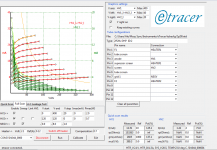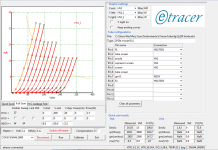I have no microphonics at all with 4P1L, and also none with 2P29L. I doubt if it's the gyrator. I would suspect the chassis. All my amps have 4mm thick soft aluminium top plates. Same with sides, unless they're wood which is also pretty dead. None of the chassis ring when they are tapped. If I tap the 2P29L itself I get a low volume high pitch ring for about 15 seconds, and then it dies out completely. I have the 2P29L stage in a chassis of its own, which happens also to be quite heavy since it contains four 126C.
My solution has always been high mass. I don't use any suspension system - just mass to kill resonances.
What's your chassis like, what weight, and does it resonate when struck in any way?
My solution has always been high mass. I don't use any suspension system - just mass to kill resonances.
What's your chassis like, what weight, and does it resonate when struck in any way?
I agree with Andy. My 4P1L is very quiet, however in my case it took about 200 hours or so to reduce the microphonic noise. My chassis is an IKEA chopping board which is less than 8mm thick I guess.
With the 2P29L I have no microphonic noise whatsoever and there are several builders out there reporting similar results.
I'm guessing is the batch of 2P29L you have Barry? I can post you a pair of 2P29L for you to test if you want.
cheers, Ale
With the 2P29L I have no microphonic noise whatsoever and there are several builders out there reporting similar results.
I'm guessing is the batch of 2P29L you have Barry? I can post you a pair of 2P29L for you to test if you want.
cheers, Ale
Hi Ale,
That’s what I don’t understand, I am not getting Microphonic noise from 4P1L! I have also been playing with PSU & my original one was based on the Siberian but rectification was with GZ33 & 2 Shottky diodes, so it was CLCRC, but changing the 220 R Resistor for a 10H choke made a huge difference. I guess I might change the whole setup for full Rectification now as well. As they say in for a penny in for a pound!
That’s what I don’t understand, I am not getting Microphonic noise from 4P1L! I have also been playing with PSU & my original one was based on the Siberian but rectification was with GZ33 & 2 Shottky diodes, so it was CLCRC, but changing the 220 R Resistor for a 10H choke made a huge difference. I guess I might change the whole setup for full Rectification now as well. As they say in for a penny in for a pound!
Hi Ale,
That’s what I don’t understand, I am not getting Microphonic noise from 4P1L! I have also been playing with PSU & my original one was based on the Siberian but rectification was with GZ33 & 2 Shottky diodes, so it was CLCRC, but changing the 220 R Resistor for a 10H choke made a huge difference. I guess I might change the whole setup for full Rectification now as well. As they say in for a penny in for a pound!
I wouldn't worry about a hybrid or Graetz bridge - it's what I use most of the time since conventional transformers without a centre tap are usually cheaper and more available. I don't think it makes too much difference. What makes a difference for me is all polypropylene caps - I use ordinary motor run caps and nothing else in the PSU.
Hi Andy,
I totally agree & I use all polyprop also, they are also more reliable, I use hybrid also because of the lower expense to performance ratio, it's just the curiosity factor regarding performance, I also prefer AZ31 to AZ1 regarding rectifier Valves, I just think the AZ1 sounds veiled in comparison, in fact prefer the GZ33 to any of them.
I totally agree & I use all polyprop also, they are also more reliable, I use hybrid also because of the lower expense to performance ratio, it's just the curiosity factor regarding performance, I also prefer AZ31 to AZ1 regarding rectifier Valves, I just think the AZ1 sounds veiled in comparison, in fact prefer the GZ33 to any of them.
The biggest difference in my setup was in the psu:
1. Go from EI Transformer to Double-C LL1683
2. Go from one rectifier setup to true dual mono with two transformer
2a. Get rid of the normal chokes and use the special amorphous core chokes of 50ae...super-resolution...
3. Go from CRC for the coleman reg to LCLC
4. Use directly heated rectifiers, I like a lot the 5c3s black plate from the 50s for it unbeatable price/performance ratio
5. go away from bridge or hybrid and use classic fw with CT.
6. I am always using Mundorf tubecap, will test oilers in comparison next...sofar they have been always extremely slow in comparison.
1. Go from EI Transformer to Double-C LL1683
2. Go from one rectifier setup to true dual mono with two transformer
2a. Get rid of the normal chokes and use the special amorphous core chokes of 50ae...super-resolution...
3. Go from CRC for the coleman reg to LCLC
4. Use directly heated rectifiers, I like a lot the 5c3s black plate from the 50s for it unbeatable price/performance ratio
5. go away from bridge or hybrid and use classic fw with CT.
6. I am always using Mundorf tubecap, will test oilers in comparison next...sofar they have been always extremely slow in comparison.
If I'm not mistaken 5C3E should work as a near perfect drop in for GZ33, I already run Filament supplies clcrc, I will try a second choke I think, especially as so much has been stated here on the plus side.
I agree with Andy on the Iron used in Filament Supply, I've tried Lundahl in previous projects & found that 159Y's (750mA 0.6H) work well for here, followed by the cheap Epcos ones, (the type Ale recommends), You save yourself serious wedge here & for a fair result IMHO.I think Frentec and I are very much on the same page here. <snip>
I agree with Andy. My 4P1L is very quiet, however in my case it took about 200 hours or so to reduce the microphonic noise. My chassis is an IKEA chopping board which is less than 8mm thick I guess.
With the 2P29L I have no microphonic noise whatsoever and there are several builders out there reporting similar results.
I'm guessing is the batch of 2P29L you have Barry? I can post you a pair of 2P29L for you to test if you want.
cheers, Ale
Hi Ale,
I would like to take you up on your offer with the 2P29L, from what everyone is saying, it’s got to be worth it.
Thanks Barry
Hi Barry,
I picked up a random pair from my stash. These are from the same supplier (I think) as the ones I've been using lately. I've not tested in my preamp as is not currently wired and also I haven't removed them from the aluminum can.
They test ok, see attached. I labeled them as "1" and "2", but only traced in triode the second valve. They are very close in pentode mode so I'd expect the same in triode.
Please email me your address so I can ship them
hope this works for you this time!
cheers
Ale
I picked up a random pair from my stash. These are from the same supplier (I think) as the ones I've been using lately. I've not tested in my preamp as is not currently wired and also I haven't removed them from the aluminum can.
They test ok, see attached. I labeled them as "1" and "2", but only traced in triode the second valve. They are very close in pentode mode so I'd expect the same in triode.
Please email me your address so I can ship them
hope this works for you this time!
cheers
Ale
Attachments
I have encountered a strange problem in my 4p1l headphone amp. It has started to emit a very faint clicking in one of the channels. Maybe it is some airborne noise from the wifi connection to my streamer, but I have never had this problem before. Can tubes become susceptible to airborne noise when they age? Or is it something else?
Probably a Valve, if it was airborne noise, I would think it would be in both channels, try removing the offending valve & reinserting it as contacts do oxidise with time.
Thank you for the suggestions. Normal noise, buzz and hum I can understand, but ticking in an amplifier is something I've never heard before. I just don't understand how a tube could start ticking all by itself. What processes are at work? However I will try swapping tubes tomorrow and see what happens.
When I built my first proper amp (I'm still a relative newbie) I got a weird noise from 1 amp and convinced myself that it was, in sequence, ...
- 5842 oscillation
- grounding of input xlr
- motorboating
Turned out to be a dodgy solder joint in the PSU return. I only found it when I started logically eliminating stuff instead of jumping on whatever wild theory caught my attention.
1) swap the valves and see if it follows
2) short the input to ground
3) I don't know your circuit, but you can eliminate the valves in turn replacing them with an appropriate resistor anode pin to cathode pin
There will be plenty of other troubleshooting tips and tricks
- 5842 oscillation
- grounding of input xlr
- motorboating
Turned out to be a dodgy solder joint in the PSU return. I only found it when I started logically eliminating stuff instead of jumping on whatever wild theory caught my attention.
1) swap the valves and see if it follows
2) short the input to ground
3) I don't know your circuit, but you can eliminate the valves in turn replacing them with an appropriate resistor anode pin to cathode pin
There will be plenty of other troubleshooting tips and tricks
I have had what you describe, who knows why, things heat up cool down, expand & contract, eventually they break. I had recently changed my 4P1L to what Ale Moglia refers to as Screen Mode, IMO it sounds better, but I have just built a 2P29L using Gyrator Boards, now that I have better Valves I prefer it to the 4P1L for a number of reasons, not least because it runs really cool!
Just a short follow up: It WAS a tube that caused the ticking sound. Great relief as I'm no fan of chasing strange noises in amplifiers. And as I was at it I changed both of the tubes as they had a few years on them. By the way does anybody know if there are differences in sound between the different vintages of 4p1l tubes? I was using a model 76 and I'm now using two 89's. Can't say I can hear much difference. The old ones was perhaps a bit more mellow but that's probably more a question of use than of vintage.
- Home
- Amplifiers
- Tubes / Valves
- 4P1L DHT Line Stage


